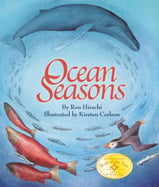Alignment to Standards for WA

| Grade | Number | Standard |
|---|---|---|
| 1 | SS-1.3.2 | Understands human interaction with the environment |
| 2 | SS-2.3.1.2a. | physical characteristics such as rivers, lakes, mountains, and parks of the community in which they live. |
| 2 | SS-2.3.2 | Understands human interaction with the environment |
| 2,3 | 2-3 ES2B | Water can be a liquid or solid and can go back and forth from one form to another. If water is turned into ice and then the ice is allowed to melt, the amount of water will be the same as it was before freezing. Water occurs in the air as rain, snow, hail |
| 2,3 | 2-3 ES2C | Weather changes from day to day and over the seasons. Weather can be described by measurable quantities, such as temperature and precipitation. |
| 2,3 | 2-3 LS1B | Animals have life cycles that include being born; developing into juveniles, adolescents, then adults; reproducing (which begins a new cycle); and eventually dying. The details of the life cycle are different for different animals. |
| 2,3 | 2-3 LS2A | Ecosystems support all life on the planet, including human life, by providing food, fresh water, and breathable air. |
| 3 | SS-3.3.1.2a. | Explains the physical geography, including landforms and climate, of Mexico, Canada, and the U.S. |
| 3 | SS-3.3.2 | Understands human interaction with the environment |
| 4,5 | 4-5 LS1B | Plants and animals have different structures and behaviors that serve different functions. |
| 4,5 | 4-5 LS1C | Certain structures and behaviors enable plants and animals to respond to changes in their environment. |
| 4,5 | 4-5 LS1D | Plants and animals have structures and behaviors that respond to internal needs. |
| 4,5 | 4-5 LS2A | An ecosystem includes all of the populations of living organisms and nonliving physical factors in a given area. Living organisms depend on one another and the nonliving physical factors in their ecosystem to help them survive. |
| 4,5 | 4-5 LS2C | Plants and animals are related in food webs with producers (plants that make their own food), consumers (animals that eat producers and/or other animals), and decomposers (primarily bacteria and fungi) that break down wastes and dead organisms, and return |
| 4,5 | 4-5 LS3B | Plants and animals inherit many characteristics from their parents. Some inherited characteristics allow organisms to better survive and reproduce in a given ecosystem. |
| 4,5 | 4-5 LS3C | Some characteristics and behaviors result from an individual plantês or animalês interactions with the environment and are not passed from one generation to the next by heredity. |
| K,1 | K-1 LS1B | All plants and animals have various external parts. |
| K,1 | K-1 LS1D | Different animals use their body parts in different ways to see, hear, grasp objects, and move from place to place. |
| K,1 | K-1 LS1E | Animals have various ways of obtaining food and water. Nearly all animals drink water or eat foods that contain water. |
| K,1 | K-1 LS2A | There are different kinds of natural areas, or habitats, where many different plants and animals live together. |
| K,1 | K-1 LS2B | A habitat supports the growth of many different plants and animals by meeting their basic needs of food, water, and shelter. |
| K,1 | K-1 LS3B | There are many different types of living things on Earth. Many of them are classified as plants or animals. |
| K,1 | K-1 LS3C.1 | Describe several external features and behaviors of animals that can be used to classify them (e.g., size, color, shape of body parts). |